Welcome to our Panda Cory Catfish care guide! If you’re looking for a peaceful and sociable fish to add to your freshwater aquarium, the Panda Cory Catfish, also known as Corydoras panda, is a fantastic choice. These small catfish are known for their black and off-white coloration pattern that resembles a giant panda, hence their name. In this guide, we’ll provide you with essential information on their care, habitat, tank setup, and more.
Core Insights to Panda Cory Catfish Care:
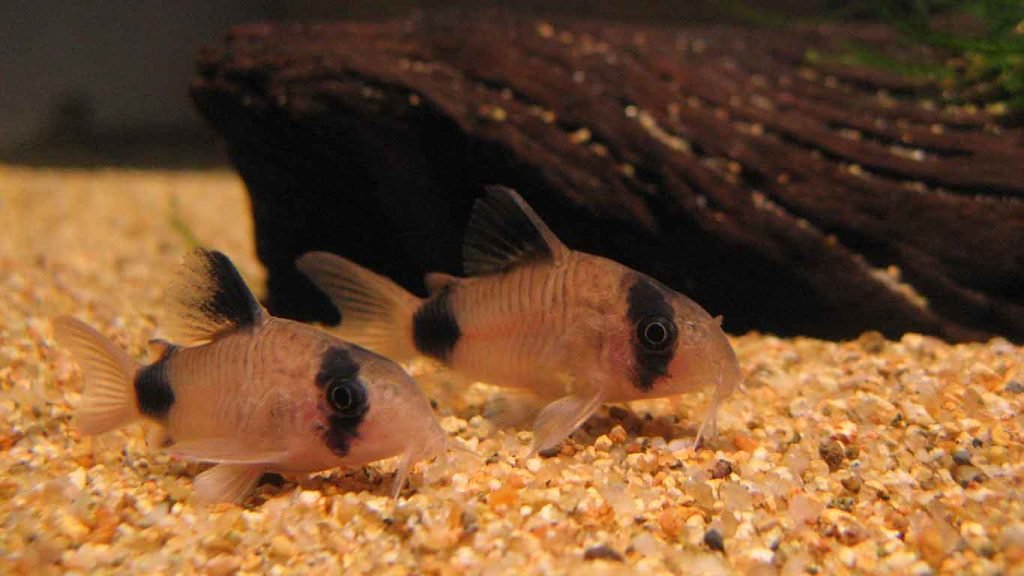
Appearance of Panda Cory Catfish
The panda cory catfish is a captivating species with its unique and striking appearance. These catfish have an off-white to faint pink body color that contrasts beautifully with three deep black markings. These markings are distinctive and give the fish its panda-like resemblance. Let’s take a closer look at the markings:
- The first black marking covers the eyes, resembling the black markings around the eyes of a giant panda.
- The second black marking covers the dorsal fin, adding a touch of elegance to their appearance.
- The third black marking is located at the base of the tail, completing the attractive pattern.
Moreover to their unique coloration, panda cory catfish have scutes instead of traditional scales, giving them a distinct texture. They also possess three sets of paired barbels, which are sensory organs that help them navigate their surroundings.
Panda cory catfish can grow up to 2 inches in length, although they often remain smaller. Despite their small size, they captivate aquarists with their charming presence. These catfish are peaceful and highly social, often found shoaling together. They enjoy the company of their own kind and thrive in community aquariums.
These captivating fish not only bring beauty to your aquarium but also add a social element, making them a delightful addition to any freshwater tank.
Habitat and Tank Conditions for Panda Cory Catfish
The panda cory catfish, native to the Ucayali river system in Peru, is a fascinating addition to any freshwater aquarium. To ensure their well-being and replicate their natural habitat, it’s important to create the right tank conditions.
Aquarium Setup
Start with a tank size of at least 10 gallons, although a larger tank of 20 gallons or more is recommended. This provides ample space for a proper school of panda cory catfish. Choose a soft and fine substrate, such as fine gravel or sand, to protect their sensitive barbels.
To imitate their natural environment, incorporate plenty of decorations like caves, rocks, and driftwood. These will provide shade and hiding places for the catfish. Live plants are also ideal for creating a natural and visually pleasing setup.
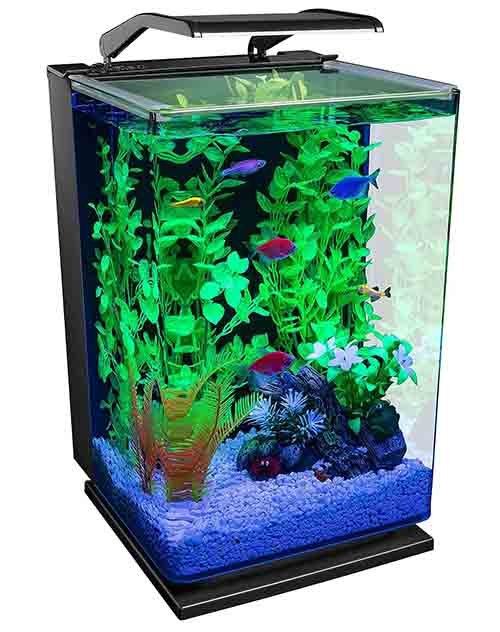
Fish Tank with LED Lighting and Filtration Included
Water Conditions
- Water Temperature: Maintain the water temperature between 68 to 77°F (20 to 25°C). Keeping it slightly lower than typical tropical species ensures their comfort.
- pH Level: Aim for a pH level between 6 to 7, which replicates their natural habitat.
- Water Hardness: Maintain water with a hardness ranging from 2 to 12 dGH.
Creating a Natural Habitat
The panda cory catfish is accustomed to clear, fast-flowing waters with sandy substrates and heavy plant cover in the wild. Recreating these conditions in the aquarium is crucial for their well-being and overall happiness.
Tank Mates
When selecting tank mates for your panda cory catfish, consider peaceful and community-oriented fish. Avoid keeping them with large or aggressive species that may harm or bully them. Compatible tank mates include tetras, danios, rasboras, and other small, peaceful catfish like aspidoras or other corydoras species.
| Panda Cory Catfish Tank Requirements | Specification |
|---|---|
| Tank Size | At least 10 gallons, preferably 20 gallons or larger |
| Substrate | Soft and fine, such as fine gravel or sand |
| Decorations | Caves, rocks, driftwood |
| Plants | Live plants to provide a natural environment |
| Water Temperature | 68 to 77°F (20 to 25°C) |
| pH Level | 6 to 7 |
| Water Hardness | 2 to 12 dGH |
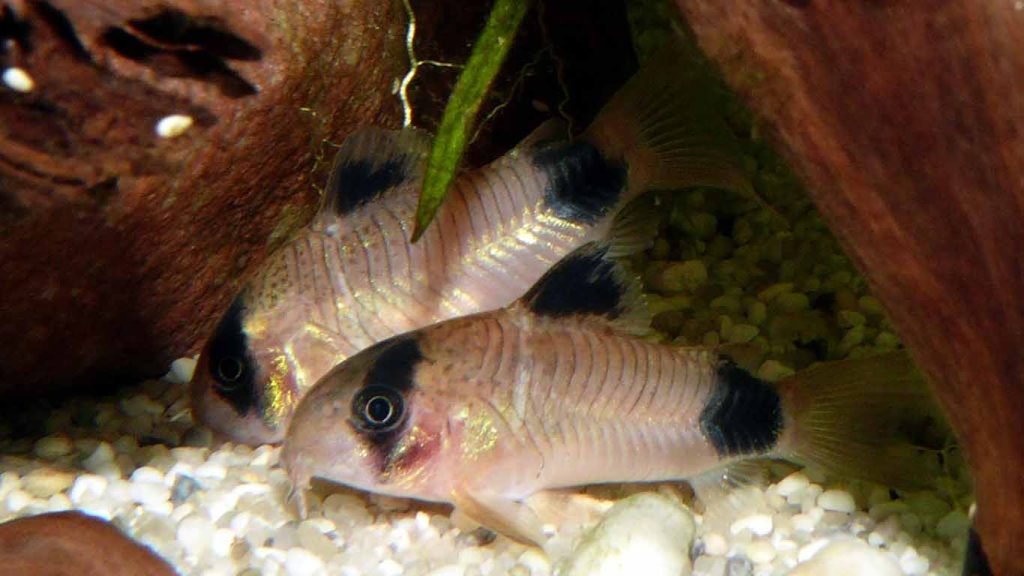
Tank Mates for Panda Cory Catfish
When it comes to tank mates for your peaceful and sociable panda cory catfish, there are plenty of options that can coexist harmoniously in a community tank. These small catfish can get along well with other small to medium-sized fish, creating a vibrant and diverse aquarium ecosystem.
Panda Cory Catfish and Peaceful Fish
Panda cory catfish are known for their peaceful nature, making them ideal companions for other peaceful fish. Their gentle temperament allows them to thrive alongside species that share a similar disposition. By selecting the right tank mates, you can create a tranquil and harmonious aquatic environment.
- Tetras: Neon tetras, cardinal tetras, and ember tetras are excellent choices as tank mates for panda cory catfish. These small, colorful fish add a vibrant touch to your aquarium while peacefully coexisting with the corydoras.
- Danios: Zebra danios and celestial pearl danios make great companions for the panda cory catfish. Their active swimming patterns and playful behavior provide an entertaining spectacle, offering a dynamic contrast to the catfish’s calm presence.
- Rasboras: Harlequin rasboras and chili rasboras are gentle, community-minded fish that enhance the beauty of your tank. These small, peaceful species create an appealing visual display and create a peaceful ambiance in the aquarium.
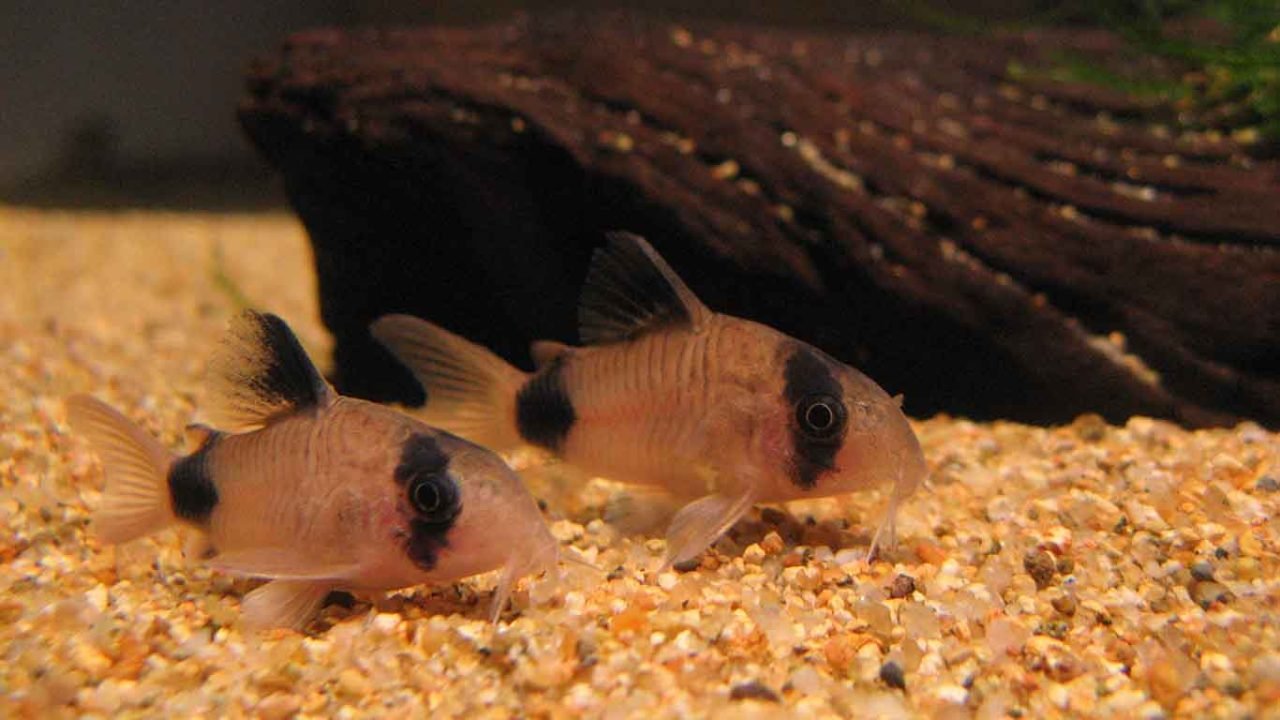
Join Our GeoZoo Family
Subscribe to our Newsletter
Panda Cory Catfish and Small Catfish Species
Moreover to peaceful fish, panda cory catfish also thrive alongside other small catfish species. By introducing these bottom-dwelling companions, you can create a diverse and lively aquarium environment.
- Aspidoras Catfish: Aspidoras catfish, also known as dwarf corydoras, are small catfish species that make great tank mates for panda cory catfish. These bottom-dwellers have similar care requirements and exhibit peaceful behavior, creating a harmonious cohabitation in the tank.
- Other Corydoras Catfish: There are various species within the corydoras genus that can coexist with panda cory catfish. Species like julii corydoras or bronze corydoras are popular choices. These small catfish share similar characteristics and habits, making for an ideal tank mate for your panda cory catfish.
When selecting tank mates for your panda cory catfish, it is crucial to avoid keeping them with large or aggressive fish that may bully or harm them. For example, tiger barbs are not recommended as tank mates due to their nipping behavior, which can cause stress and discomfort to the panda cory catfish.
In the company of peaceful fish and compatible catfish species, your panda cory catfish will thrive and contribute to a vibrant and harmonious community tank.

Diet of Panda Cory Catfish
Panda cory catfish are omnivores and thrive on a varied diet. They are bottom-dwellers and scavenge for food that falls to the tank bottom. Sinking food tablets or pellets are ideal for ensuring that enough food reaches them in a community tank. They also enjoy meaty foods, such as live or frozen shrimp, worms, insects, and crustaceans. Prepared food tablets formulated specifically for cory catfish are also a good choice. It is important to provide a balanced diet to ensure their optimal health.
Feeding Panda Cory Catfish
Feeding panda cory catfish is relatively straightforward. As omnivores, they require a combination of plant matter and protein-rich foods to meet their dietary needs. Here are some key points to remember when feeding your panda cory catfish:
- Offer sinking food tablets or pellets as the staple diet. These specialized catfish foods sink to the bottom, making it easier for the panda cory catfish to access their meals.
- Supplement their diet with meaty foods like live or frozen shrimp, worms, insects, and crustaceans. These protein-rich treats provide essential nutrients and help replicate their natural diet in the wild.
- Include vegetable-based foods, such as algae wafers or blanched vegetables like spinach or zucchini. These plant-based options provide additional nutrition and fiber.
- Avoid overfeeding. Feed your panda cory catfish small portions several times a day, ensuring that they consume all the food within a few minutes. This helps prevent overeating and maintains good water quality in the tank.

Sinking Catfish Pellets with Shrimp
Remember to observe your panda cory catfish’s eating habits and adjust their diet accordingly. Providing a balanced and varied diet ensures their health and allows them to thrive in your aquarium.
“Offer sinking food tablets or pellets as the staple diet.”
To ensure the well-being of your panda cory catfish, it is essential to provide a balanced diet that meets their nutritional requirements. A combination of sinking food tablets or pellets, meaty foods, and plant-based options will help maintain their optimal health. Observing their feeding habits and adjusting their diet accordingly helps promote their overall well-being.

Care Tips for Panda Cory Catfish
Proper care is essential for the well-being of panda cory catfish. By following these care tips, you can ensure that your freshwater catfish thrives in your aquarium.
- Water Quality: Maintaining good water quality is crucial for the health of your panda cory catfish. Regular water changes and a reliable filtration system are necessary to keep the water clean and free from toxins.
- Water Parameters: Panda cory catfish prefer slightly lower temperatures than other tropical species. Keep the water temperature between 68 to 77°F (20 to 25°C). It is also important to maintain a pH level between 6 to 7 and a water hardness ranging from 2 to 12 dGH to mimic their natural habitat.
- Hiding Spots and Shade: Providing plenty of hiding spots, such as rocks, caves, and driftwood, is essential for the comfort and well-being of your panda cory catfish. These hiding spots also help reduce stress and create a more natural environment. Additionally, offering shade through the use of plants or decorations will help mimic their natural habitat.
- Substrate: Choose a soft and fine substrate, such as sand or fine gravel, to protect the sensitive barbels of your panda cory catfish. Avoid rough or sharp substrates that may cause injuries.
- Monitoring and Maintenance: Regularly monitor your aquarium to ensure that the water parameters remain stable and within the recommended range. Conduct routine maintenance, such as cleaning algae, removing debris, and checking the filtration system, to keep the tank clean and healthy.
“Proper care is essential for the well-being of panda cory catfish.”
Keeping these care tips in mind will help create a suitable environment for your panda cory catfish, ensuring their overall well-being and longevity.
Example Table: Comparison of Water Parameters
| Parameter | Ideal Range for Panda Cory Catfish | Ideal Range for Tropical Fish |
|---|---|---|
| Water Temperature | 68-77°F (20-25°C) | 75-82°F (24-28°C) |
| pH Level | 6-7 | 6.5-7.5 |
| Water Hardness (dGH) | 2-12 | 4-12 |
By providing proper care and maintaining suitable tank conditions, you can ensure that your panda cory catfish thrives and remains a beautiful addition to your freshwater aquarium.
Breeding Panda Cory Catfish
Breeding panda cory catfish is a rewarding endeavor that can be achieved in the comfort of your own home aquarium. To successfully breed these freshwater catfish, a separate breeding tank with specific conditions is necessary.
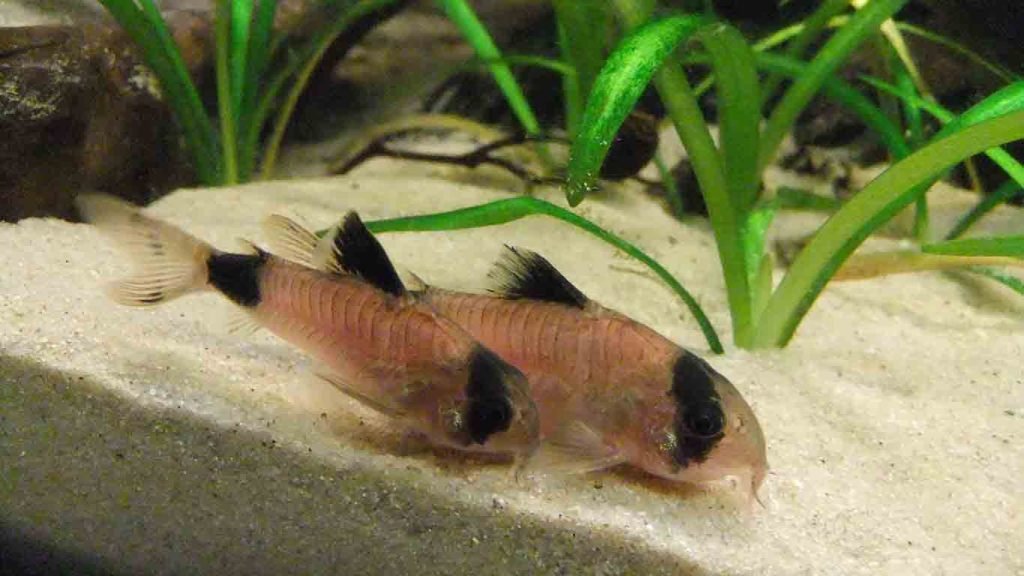
When setting up the breeding tank, it is important to provide suitable vegetation for the eggs to be deposited upon. Java moss or other fine-leaved plants are ideal choices for this purpose. Creating a natural and comfortable environment for the panda cory catfish breeders is crucial.
Before initiating the breeding process, it is recommended to condition the breeding pair with live foods. Bloodworms, brine shrimp, or daphnia can be provided to enrich their diet and enhance their chances of successful breeding.
Spawning can be triggered by conducting a partial water change with slightly cooler water. This change in temperature can simulate the natural breeding conditions for the fish. As the female panda cory catfish accepts the male’s advances, the eggs will be fertilized and carefully deposited onto the vegetative surface.
After spawning, it is essential to maintain the appropriate water conditions for the eggs to develop. The eggs will typically hatch within four days, and the fry will require proper care and feeding to ensure their healthy growth.
With patience and dedication, breeding panda cory catfish can be a fascinating and fulfilling experience. The sight of the tiny fry swimming in the aquarium will bring joy to any freshwater fish enthusiast.
| Step | Description |
|---|---|
| 1 | Set up a separate breeding tank with fine-leaved plants, such as Java moss. |
| 2 | Condition the breeding pair with live foods, such as bloodworms, brine shrimp, or daphnia. |
| 3 | Trigger spawning by conducting a partial water change with slightly cooler water. |
| 4 | Observe the female accepting the male’s advances and fertilizing the eggs, which will be deposited on the vegetation. |
| 5 | Maintain optimal water conditions for the eggs to develop, with proper temperature, pH, and filtration. |
| 6 | Monitor the eggs until they hatch, which typically takes about four days. |
| 7 | Provide proper care and feeding for the fry to ensure their healthy growth. |
Panda Cory Catfish Natural Habitat
The panda cory catfish, also known as panda corydoras catfish, is a species native to the Ucayali river system in Peru. This river system is part of the vast and biodiverse Amazon River basin. The panda cory catfish is well-adapted to the unique conditions found in this region.

The natural habitat of the panda cory catfish is characterized by clear and fast-flowing waters. These waters are typically found in areas with sandy substrates and heavy plant cover. The presence of plants provides the catfish with ample hiding spots and shade, which they seek for comfort and security.
The Ucayali river system is known for its blackwater conditions, which are characterized by slightly acidic and soft water. These conditions are created by the presence of decaying organic matter, such as leaves and tannins, in the water. In addition, the water temperature in their natural habitat ranges from the mid to low 70s Fahrenheit, creating a warm and tropical environment that the panda cory catfish thrives in.
To ensure the well-being of panda cory catfish in aquariums, it is important to replicate their natural habitat as closely as possible. This includes providing clear and well-oxygenated water with a slightly acidic pH and soft water hardness. The use of a sandy substrate and the inclusion of live plants, rocks, and driftwood will help recreate the natural environment and provide the catfish with the necessary hiding places and shade.
| Characteristic | Description |
|---|---|
| Native Region | Ucayali river system in Peru, part of the Amazon River basin |
| Water Conditions | Slightly acidic, soft, and clear water with blackwater characteristics |
| Substrate | Sandy substrates |
| Plant Cover | Heavy plant cover providing shade and hiding places |
| Water Temperature | Mid to low 70s Fahrenheit |

Purchasing Panda Cory Catfish
Panda cory catfish are highly sought after in the pet trade and can be easily obtained from reputable aquarium stores or online. Whether you’re a beginner or an experienced aquarist, adding these captivating tropical freshwater fish to your collection can bring joy and beauty to your aquarium.
When purchasing panda cory catfish, it’s essential to select healthy specimens from trusted sources. Look for active and alert fish that exhibit no signs of disease or physical abnormalities. Healthy panda cory catfish have clear eyes, intact fins, and vibrant colors. Take the time to observe them closely and ensure they are active and swimming freely.
It is recommended to prioritize obtaining captive-bred panda cory catfish rather than wild-caught individuals. Captive-bred specimens are more readily available, affordable, and have a higher chance of adapting well to the aquarium environment.
When bringing your new panda cory catfish home, it’s crucial to acclimate them slowly to their new surroundings. The transition process helps reduce stress and promotes their well-being. Float the sealed bag containing the fish in the aquarium for about 15-20 minutes to equalize the temperature. Afterward, open the bag and gradually add small amounts of the aquarium water to the bag over a period of about 30 minutes. Gently release the fish into the aquarium using a net, being careful not to introduce any bag water into the tank.
By selecting healthy panda cory catfish from reputable sources and providing them with a smooth transition into your aquarium, you can ensure the best start for these delightful tropical fish in their new home.
Tank Setup for Panda Cory Catfish
Creating a suitable tank setup for panda cory catfish is crucial for their overall well-being. Here are some important considerations when setting up their aquarium:
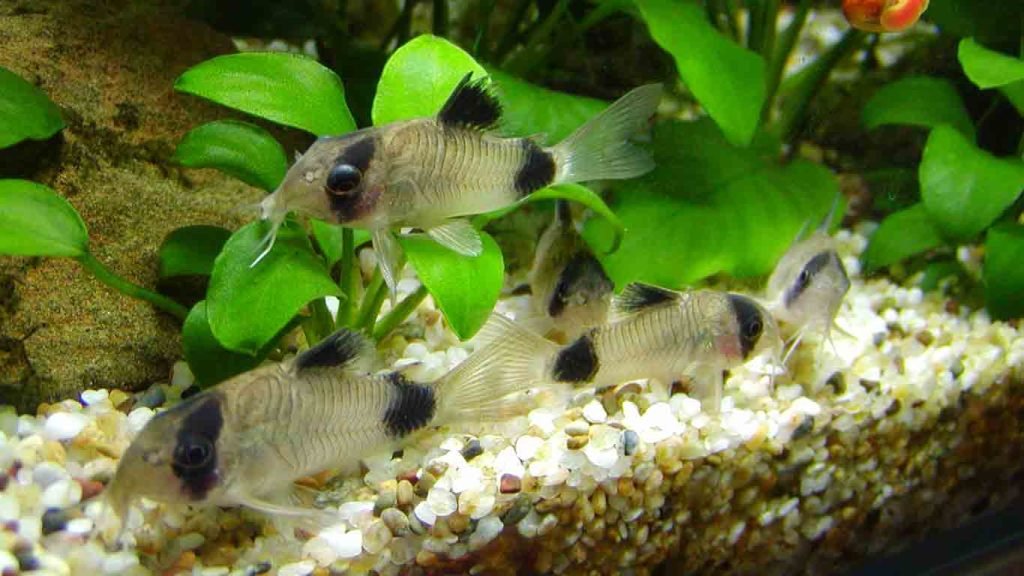
Tank Size
A tank size of at least 10 gallons is recommended for panda cory catfish. However, a larger tank of 20 gallons or more is preferable as it provides more swimming space and allows for a proper school. These catfish are social creatures and thrive in groups, so having enough space for them to swim and interact is essential.
Substrate
Choose a soft and fine substrate for your panda cory catfish tank, such as sand or fine gravel. The delicate barbels of these catfish are sensitive, and a rough substrate can cause damage and stress. A soft substrate also mimics their natural environment and allows them to forage comfortably.
Decoration
Add live plants, rocks, caves, and driftwood to your aquarium to create hiding places and shade for your panda cory catfish. These catfish enjoy exploring and hiding, and providing suitable hiding spots helps reduce stress and mimic their natural habitat. Live plants also contribute to the overall health of the tank by providing oxygen and filtration.
Filtration and Water Parameters
A good filtration system is crucial for maintaining water quality in the panda cory catfish tank. These catfish produce waste like any other fish, and a reliable filtration system helps keep the water clean and free from toxins. Regular water changes are also important to maintain stable water parameters. Panda cory catfish prefer slightly acidic water with a pH range of 6 to 7 and a water hardness between 2 to 12 dGH.

Tetra Whisper In-Tank Filtration With Air Pump
| Tank Setup for Panda Cory Catfish | Summary |
|---|---|
| Tank Size | At least 10 gallons, preferably 20 gallons or more for a proper school |
| Substrate | Soft and fine, such as sand or fine gravel |
| Decoration | Live plants, rocks, caves, and driftwood for hiding places and shade |
| Filtration and Water Parameters | Good filtration system, regular water changes, slightly acidic water (pH 6-7), water hardness 2-12 dGH |
By providing a well-designed and suitable tank setup, you can ensure the health and happiness of your panda cory catfish. Remember to monitor water parameters regularly, provide a balanced diet, and create an enriching environment for these fascinating freshwater fish.

Join Our GeoZoo Family
Subscribe to our Newsletter
Final Remarks
Panda cory catfish care is essential for these popular and sociable freshwater catfish. With their peaceful nature and social behavior, they make an excellent addition to tropical community tanks. By providing the right tank setup, suitable tank mates, and a varied diet, you can ensure the well-being and longevity of these bottom-dwelling catfish.
Remember to create a comfortable habitat for your panda cory catfish by incorporating live plants, caves, and driftwood. Maintaining good water quality, regular water changes, and stable water parameters are crucial for their optimal health. Additionally, offering sinking food tablets or pellets and meaty foods will provide them with a balanced diet.
If you’re interested in breeding panda cory catfish, establishing a separate breeding tank with the right conditions is necessary. With proper conditioning, these catfish can successfully spawn and produce offspring. Captive-bred specimens are readily available to aquarium enthusiasts, making it easier to find healthy and acclimated panda cory catfish for your home aquarium.
In the end, panda cory catfish care requires attention to their tank setup, tank mates, diet, and breeding conditions. With their captivating appearance and peaceful demeanor, these catfish bring life and joy to any freshwater aquarium. By following the proper care guidelines, you can enjoy the company of these delightful and fascinating fish for many years to come.
FAQ
What is a panda cory catfish?
A panda cory catfish, or panda catfish, is a South American species of catfish known as Corydoras panda. It has a black and off-white coloration pattern similar to a giant panda.
How big do panda cory catfish get?
Panda cory catfish can grow up to 2 inches in length, although they often remain smaller.
What kind of tank setup do panda cory catfish need?
Panda cory catfish prefer a soft and fine substrate, such as fine gravel or sand, and thrive in tanks with plenty of decoration like caves, rocks, and driftwood to provide shade and hiding places. Live plants are also ideal for creating a natural environment for them.
Can panda cory catfish be kept with other fish?
Yes, panda cory catfish are peaceful and sociable fish that can be kept with a variety of tank mates, such as tetras, danios, rasboras, and other small catfish species. However, it is important to avoid keeping them with large or aggressive fish that may bully or harm them.
What do panda cory catfish eat?
Panda cory catfish are omnivores and thrive on a varied diet. They eat sinking food tablets or pellets, meaty foods like live or frozen shrimp, worms, insects, and crustaceans, and prepared food tablets formulated for catfish.
How should I care for panda cory catfish?
Proper care for panda cory catfish includes maintaining good water quality, regular water changes, providing suitable tank conditions with hiding spots and a proper substrate, and offering a balanced diet. Regular monitoring and maintenance of the aquarium are also necessary.
Can I breed panda cory catfish in my home aquarium?
Yes, breeding panda cory catfish is possible with some effort. A separate breeding tank with suitable conditions is necessary, including live plants for the eggs to be deposited upon. The breeders should be well-conditioned with live foods, and spawning can be triggered by a partial water change with slightly cooler water.
Where do panda cory catfish come from?
Panda cory catfish originate from the Ucayali river system in Peru, part of the Amazon River basin. In the wild, they inhabit clear, fast-flowing waters with sandy substrates and heavy plant cover.
Where can I purchase panda cory catfish?
Panda cory catfish are easily found in pet stores or online. It is important to choose healthy specimens from reputable sources. Captive-bred specimens are more common and affordable.
How should I set up a tank for panda cory catfish?
A tank size of at least 10 gallons is recommended, but a larger tank of 20 gallons or more is preferable to allow for a proper school. The substrate should be soft and fine, like sand or fine gravel, and live plants, rocks, caves, and driftwood should be included for hiding places and shade. A good filtration system, regular water changes, and stable water parameters are important.
Any final tips for caring for panda cory catfish?
Providing suitable tank mates, proper water conditions, a varied diet, and suitable tank setup are essential for the well-being of panda cory catfish. Regular monitoring and maintenance of the aquarium are also necessary to ensure their optimal health and enjoyment.

